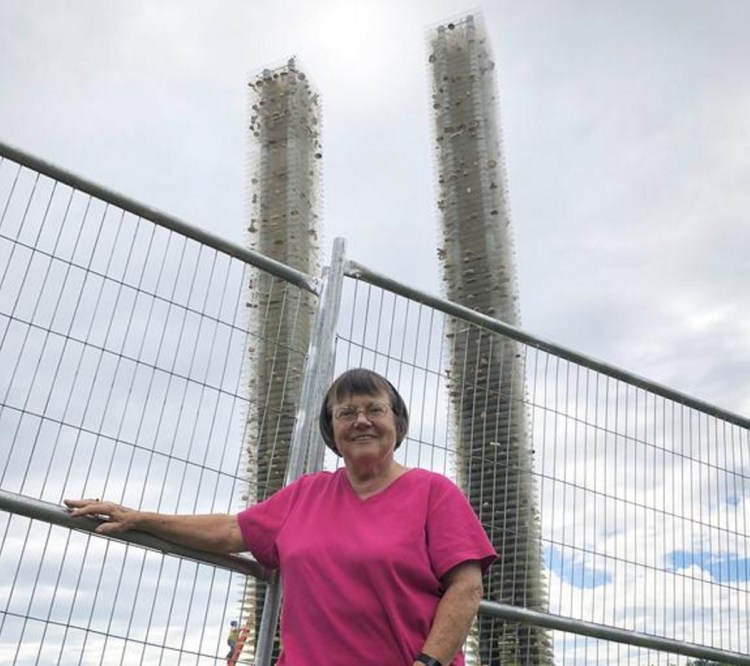TOPSHAM — It was a sunny Tuesday on a late summer morning. Chris Chapman’s ceramics class at Mt. Ararat High School was drawing shells when the visual arts teacher was advised to check the news.
The haunting image of two planes crashing into the World Trade Center’s Twin Towers seared into her mind that morning, and into the minds of her students and people around the world.
Now 17 years after Sept. 11, 2001, a school monument to the lives lost that day has a renewed focus, and much greater visibility, because construction of a new school has cleared the land around the memorial.
On 9/11, Chapman directed her stunned students to sink their hands into balls of clay, letting their emotions guide them. The result was not important; the act was.
The tragedy haunted her that night. “The overwhelming feeling was that we need to do something, but nobody knew what to do,” she recalled last month. “We didn’t know, the kids didn’t know.”
But art provided an answer.
Chapman wanted to honor the approximately 3,000 lives lost in New York, Washington, D.C., and Shanksville, Pennsylvania.
The result was the two pillars outside the school, a homage to the Twin Towers.
Each is 22 feet tall, with 110 floors. Composed of Plexiglas, they have all these years held thousands of clay objects Mt. Ararat students molded in memory of those who were lost.
With the entire school backing her “Remembrance Project,” all 88 home rooms received a bag containing 65 balls of clay.
“In the course of a month, everybody made their tokens of shared loss,” Chapman recalled, “by thinking about how they felt, just a squish or an image.”
Terracotta, porcelain, and white and brown clays were used, fired to different temperatures “so there’d be a little variety in color, to reflect the humanity that was lost,” Chapman remembered as she visited the pillars recently.
Since a 22-foot-tall structure would be too big to house indoors, space was found near a pond between the school and its athletic fields. The Plexiglas, the steel columns and PVC pipe spacers to support the pillars – placed a few feet underground – were all donated.
“Everybody came together to do it,” Chapman said. “The thing that was so remarkable was that everybody needed to do something. We all needed to heal (from) something that was overwhelming to all of us.”
The Harpswell woman retired in 2007 after teaching at Mt. Ararat for 33 years, although she returned for a semester in 2009.
“It’s so different than today,” she remarked. “Everybody came together. Everybody wanted to be part of that healing. … It was really a tribute to the unity of Mt. Ararat.”
The memorial was dedicated on Dec. 11, 2001. Chapman called it “an act of grace.”
Recent years saw the twin pillars fall into some obscurity. Shrubbery around the secluded area, changing staff, and students born after the terrorist attacks contributed to the Remembrance Project fading out of awareness, its pillars relegated to objects of curiosity.
“A lot of people never really knew the story behind it,” Principal Donna Brunette said last month.
Chapman shared a written history of the project with Brunette in April, after seeing the pillars once again in April during Mt. Ararat’s annual Capstone Day. Brunette found the narrative eye-opening.
“I never had this history, to even share with other kids, because I wasn’t here at the time,” Brunette said.
Clearing of the area around the athletic fields in recent months to make way for a new Mt. Ararat High School has allowed the pillars to gain visual prominence on the Eagles Way campus. They are so close to the new structure, due to be complete in 2020, that they’re inside the fence around the construction perimeter.
With the new attention brought to them, Chapman said she is “amazed that they retained their importance.”
She also said she hopes the sense of American unity borne out of 9/11 would resurface if another tragedy of that magnitude occurs. It was a force of communal grieving and healing that continues to resonate within her.
“I really felt I was driven,” Chapman said. “And it wasn’t me; it was beyond me. It was just something I needed to do, and I got support all along the way, and everything fell into place.”
Brunette plans to send Chapman’s narrative to all the teachers on Tuesday, “to read it on the anniversary, so that all the kids here, and all the adults here, will know the story.
“It’s a sign of hope. We want them to continue to see that,” she said, “and see (the memorial) for what it was built to be.”
Alex Lear can be contacted at 781-3661 ext. 113 or at:
alear@theforecaster.net
Twitter: @learics
See this story at The Forecaster.
Send questions/comments to the editors.



Success. Please wait for the page to reload. If the page does not reload within 5 seconds, please refresh the page.
Enter your email and password to access comments.
Hi, to comment on stories you must . This profile is in addition to your subscription and website login.
Already have a commenting profile? .
Invalid username/password.
Please check your email to confirm and complete your registration.
Only subscribers are eligible to post comments. Please subscribe or login first for digital access. Here’s why.
Use the form below to reset your password. When you've submitted your account email, we will send an email with a reset code.